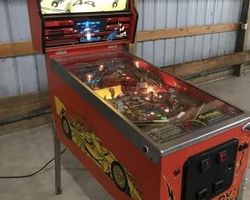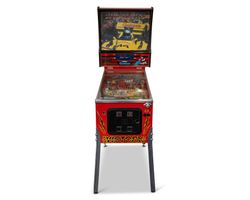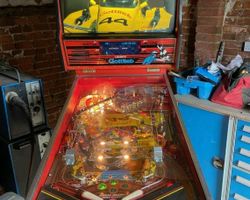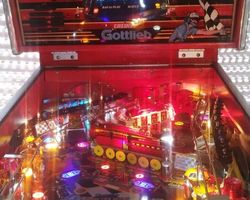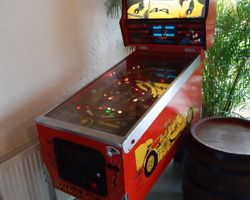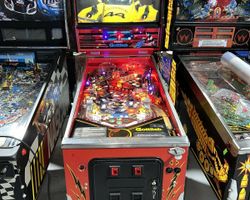Victory
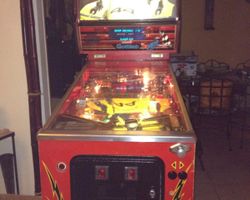
Average Prices: USD $300 to $1,400
Produced: October, 1987
Production Run: 3,315 units
Machine Type: Solid State Electronic
MPU: Gottlieb System 80B
Players: 4
Design by: John Trudeau
Art by: Constantino Mitchell, Jeanine Mitchell
Sound by: Dave Zabriskie
Software by: John Buras
"Victory," a pinball machine from October 1987, emerged from D. Gottlieb & Co., a manufacturer in a period of transition under the Premier Technology banner. Conceived by designer John Trudeau, with art by Constantino Mitchell and Jeanine Mitchell, software by John Buras, and sound and music by Dave Zabriskie, this solid-state electronic game aimed to capture the exhilaration of auto racing. Its production run of 3,315 units marked it as a significant release for the company during the late 1980s. A point of historical interest surrounds the game's development: John Borg, who would go on to design many popular machines, began his tenure at Gottlieb/Premier in 1987, with "Victory" being the first game where he contributed. Furthermore, the initial whitewood concept for "Victory" explored a radical lower playfield design featuring a race car that would advance with player progression, an ambitious idea ultimately deemed too costly to implement.
Signature Features and Design
"Victory" introduced several elements that defined its identity. Most notably, it was the first pinball machine to utilize a fully screened, photorealisitic "Vitrigraph" mylar overlay for its playfield. This innovative process, developed exclusively by Premier, diverged from the industry standard of directly silkscreening art onto the wood. The Vitrigraph application was intended to provide a more vibrant and detailed aesthetic. While "Victory" pioneered this method, the technology faced adhesion issues in the field, leading to a limited run of replacement playfields that reverted to traditional silkscreening on wood, protected by a clear mylar overlay. These replacement playfields sometimes featured subtle artistic differences, such as a simpler checkered flag in the center without the race car or "Gottlieb Victory" text, and altered color schemes for elements like the racetrack and text.
Beyond its unique playfield manufacturing, "Victory" stood out with its multi-leveled playfield, a feature that immediately added depth and complexity to the game. It incorporated four flippers, two distinct ramps, and two spinning targets, all contributing to a challenging and dynamic play experience. Custom speech and an 11-channel soundboard enhanced the racing theme, though some audio elements would later be described as repetitive. The backbox featured a 40-character alphanumeric display for scoring and game information. The cabinet itself was rendered in a bright, eye-catching red, fitting the high-speed racing theme, while the translite combined hand-drawn and photographic elements.
Playfield and Mechanics
The playfield layout of "Victory" is distinct and geared towards precision shooting. It features two ramps: one leading to an upper playfield section and another offering a primary scoring route. The main playfield is populated with seven standup targets and a central four-bank of drop targets, critical for advancing gameplay objectives. A kick-out hole and a ball kicker provide interactive elements, often used for locking balls or initiating specific sequences. Unusually for its era, "Victory" does not include any pop bumpers, which influences the ball's movement and shot opportunities, placing a greater emphasis on player control and direct target hitting rather than chaotic ricochets.
The design philosophy behind "Victory's" layout prioritizes a linear progression, guiding players through a "race" by hitting specific shots to advance checkpoints. This focus demands accuracy and an understanding of the shot paths. The upper playfield, accessed via a ramp, adds another dimension, requiring a precise shot to reach and navigate its elevated features. This elevated area often serves as a key location for completing objectives or scoring multipliers. The artwork on the playfield, while functional and thematic, contributes to the overall racing aesthetic, though some smaller text elements were noted as being difficult to read due to their color and size. The lighting scheme is designed to highlight active shots and progression, drawing the player's eye towards the next objective in the "race."
Gameplay Dynamics
The core objective of "Victory" revolves around the concept of completing a high-speed race. Players must navigate a series of "checkpoints," which are typically achieved by hitting specific targets, ramps, or spinners in a designated sequence. This progression is largely linear, tasking players with precise, timed skill shots to advance through the "race stages." The game rewards accuracy and quick reflexes, as many scoring opportunities and objective completions are time-sensitive.
While "Victory" does feature a single multiball, it is not the central chaotic element often found in other machines. Instead, the gameplay largely focuses on mastering the flow and hitting specific, often tight, shots to move forward. The scoring system is straightforward, with an 8-digit display and opportunities for scoring multipliers when specific conditions are met, such as hitting flashing targets. Objectives often involve activating a scoring multiplier or progressing to the next checkpoint. For instance, successfully hitting the drop targets might open a path to a ramp shot, which then advances the player's position in the race. Challenges include the precise nature of the shots, which can be deceptively difficult, and the need to maintain control over the ball to execute sequences. Long ball times can be achieved by skilled players, allowing for extensive practice of these critical shots and target sequences.
Reception and Legacy
"Victory" has garnered a mixed yet generally positive reception within the pinball community. Its strengths are frequently highlighted as its unique racing theme, which is effectively integrated into the gameplay, and its creative, albeit challenging, playfield layout. Many players commend it as a "shooter's game," requiring and rewarding precision and accuracy. The presence of an upper playfield is often cited as a positive feature, adding depth and a distinct element to the gameplay. The music is generally praised as upbeat and catchy, contributing positively to the racing atmosphere. Furthermore, for its cost, "Victory" is often considered to offer good value, making it an accessible option for collectors and enthusiasts. Despite the initial production issues, the "Vitrigraph" playfields are generally considered durable once installed correctly.
Conversely, "Victory" faces criticism for aspects that diminish its long-term appeal for some. A common sentiment is that the game can become repetitive after a few plays, as its core objective, the linear "race" progression, can feel like a grind once mastered. While the concept of a single multiball is present, its implementation is not as central or chaotic as in other games, leading some to perceive a "lack of multiball" and its associated high-scoring potential. The sound effects and voice calls are often described as dull or repetitive, failing to maintain engagement over extended play sessions. The backglass artwork is frequently singled out as underwhelming, with some players suggesting it detracts from the machine's overall aesthetic. Additionally, the small, blue score text on the alphanumeric display can be difficult to read. The absence of pop bumpers, a staple in many pinball machines, is also noted by some as a missed opportunity for more dynamic ball movement.
Despite these criticisms, "Victory" holds a distinct place in pinball history, particularly as part of Gottlieb's System 80B era. It is often regarded as an underrated machine from the 1980s, offering a unique experience for its price point. Its pioneering use of the "Vitrigraph" playfield, while problematic in its initial execution, represents an interesting, albeit short-lived, attempt at playfield manufacturing innovation by Premier Technology. Its linear, precision-focused gameplay sets it apart from many other machines of its time, securing its niche among players who appreciate a demanding, skill-based pinball challenge.
Sponsored Links
 Ebay Listings
Ebay Listings
 Auction Results
Auction Results
| Cost | Location | Date |
|---|---|---|
| GBP £2,000 |  United Kingdom United Kingdom |
30 April, 2025 |
| EUR €2,950 |  Baden-Württemberg, Germany Baden-Württemberg, Germany |
06 February, 2025 |
| USD $2,000 |  Wisconsin, United States Wisconsin, United States |
31 January, 2025 |
| USD $1,400 |  Maryland, United States Maryland, United States |
06 June, 2024 |
| USD $2,500 |  Vermont, United States Vermont, United States |
10 March, 2023 |
| USD $4,000 |  Texas, United States Texas, United States |
22 September, 2022 |
| EUR €1,350 |  Baden-Württemberg, Germany Baden-Württemberg, Germany |
19 July, 2022 |
| USD $2,600 |  Kansas, United States Kansas, United States |
03 June, 2022 |
| USD $6,499 |  California, United States California, United States |
19 January, 2022 |
| USD $2,000 |  Vermont, United States Vermont, United States |
29 September, 2021 |


Private Policy · Search Website · Contact Us
As an eBay Partner, we may earn a commission from qualifying purchases made through links on this site, at no additional cost to you.
All trademarks and copyrighted materials remain property of their respective owners. All other content copyright 2007 - 2025 Pinpedia.

